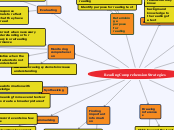Reading Comprehension Strategies
Determining a purpose for reading
Identify purpose for reading text
Select purpose for reading text
adjust reading strategies and reading
rate to match the purpose for reading
Activating prior knowledge
Bring background knowledge to the reading of a text
Use brainstorming activities to recall what they know
Visualizing
Guide the generation of
images
Use visual arts and drama
Questioning
Ask questions that will help them
focus on the meaning
Understand how questioning helps
them remember information
Ask "thick"questions
Why
What if
Ask "thin" questions
Who
When
Making connections
Extend the meaning in text by connecting it to various elements
the world around them
Other texts
Character
Information
plot
Setting
Topic
Predicting
Integrate cueing systems
Use anticipation guides
Make prediction based on:
topic
familiar features
author
genre
Drawing inferences
Combine what they know with clues
from the text to make deductions
Think beyond the text during teacher
read-alouds as they model how to
draw inferences during reading
Finding important information
Set purposes for reading that will help
them determine what is important
Use print features to locate
important information
Punctuation
Headers
Font changes
Summarizing
Summarize stories through retelling,
dramatizing, or illustrating stories
Use oral and visual summaries,
concept maps, and discussions to
help students summarize texts
Use jot notes to record events in
a few words/sentences
Synthesizing
Synthesize new
information with existing knowledge
Gather meaning from several texts
or genres to create a broader picture
of a topic
Evaluating
Use response journals to reflect on what they have just read
Identify valid sources of information
Website analysis
Magazine critiques
Make judgements before, during, and
after reading
Monitoring comprehension
Use all the cueing systems to
increase understanding
Modelling
using a think-aloud strategy
Self-correct when necessary for
understanding or for accuracy in oral
reading performance
Notice when the students do not understand
